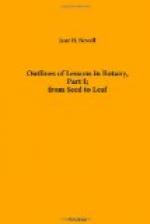[Footnote 1: See page 34.]
These ribs and veins are the woody framework of the leaf, supporting the soft green pulp. The woody bundles are continuous with those of the stem, and carry the crude sap, brought from the roots, into the cells of every part of the leaf, where it is brought into contact with the external air, and the process of making food (Assimilation 4) is carried on. “Physiologically, leaves are green expansions borne by the stern, outspread in the air and light, in which assimilation and the processes connected with it are carried on."[1]
[Footnote 1: Gray’s Structural Botany, p. 85.]
The whole leaf is covered with a delicate skin, or epidermis, continuous with that of the stem.[1]
[Footnote 1: Reader in Botany. XI. Protection of Leaves from the Attacks of Animals.]
2. Descriptions.—As yet the pupils have had no practice in writing technical descriptions. This sort of work may be begun when they come to the study of leaves. In winter a collection of pressed specimens will be useful. Do not attach importance to the memorizing of terms. Let them be looked up as they are needed, and they will become fixed by practice. The pupils may fill out such schedules as the following with any leaves that are at hand.
SCHEDULE FOR LEAVES.
Arrangement Alternate[1]
|Simple or compound. Simple |(arr. and no. of leaflets) | |Venation Netted and | feather-veined |Shape Oval 1. BLADE < | Apex Acute | | Base Oblique | |Margin Slightly wavy | |Surface Smooth
2. PETIOLE Short; hairy
3. STIPULES Deciduous
Remarks. Veins prominent and very straight.
[Footnote 1: The specimen described is a leaf of Copper Beech.]
In describing shapes, etc., the pupils can find the terms in the book as they need them. It is desirable at first to give leaves that are easily matched with the terms, keeping those which need compound words, such as lance-ovate, etc., to come later. The pupils are more interested if they are allowed to press and keep the specimens they have described. It is not well to put the pressed leaves in their note books, as it is difficult to write in the books without spoiling the specimens. It is better to mount the specimens on white paper, keeping these sheets in brown paper covers. The pupils can make illustrations for themselves by sorting leaves according to the shapes, outlines, etc., and mounting them.




